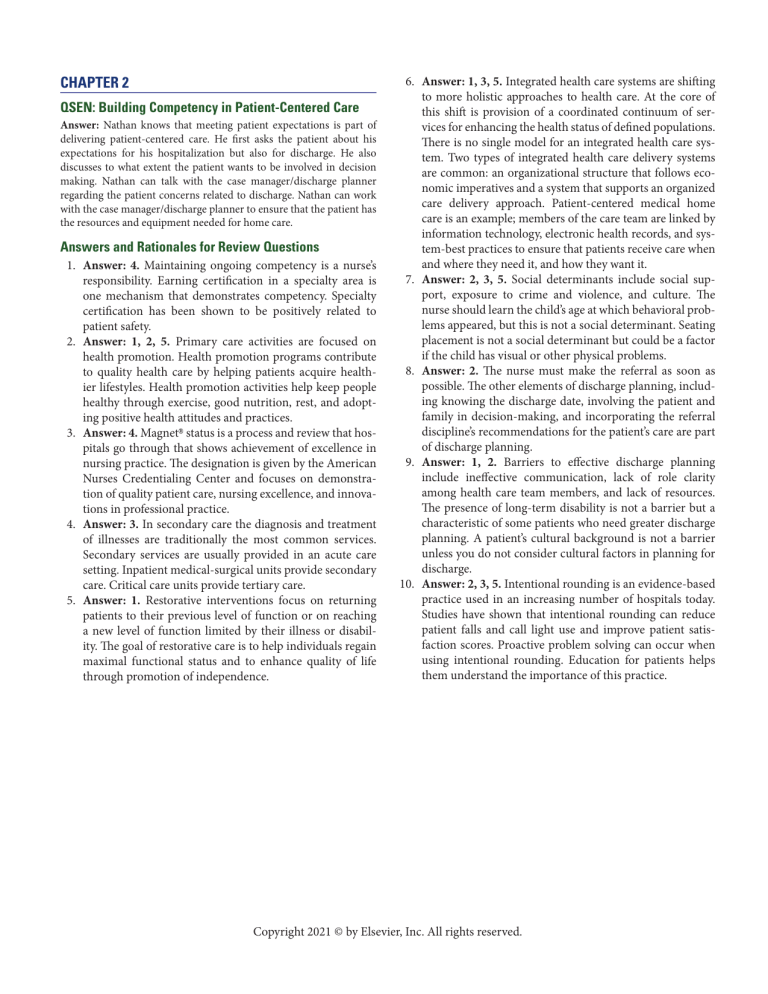
CHAPTER 2 QSEN: Building Competency in Patient-Centered Care Answer: Nathan knows that meeting patient expectations is part of delivering patient-centered care. He first asks the patient about his expectations for his hospitalization but also for discharge. He also discusses to what extent the patient wants to be involved in decision making. Nathan can talk with the case manager/discharge planner regarding the patient concerns related to discharge. Nathan can work with the case manager/discharge planner to ensure that the patient has the resources and equipment needed for home care. Answers and Rationales for Review Questions 1. Answer: 4. Maintaining ongoing competency is a nurse’s responsibility. Earning certification in a specialty area is one mechanism that demonstrates competency. Specialty certification has been shown to be positively related to patient safety. 2. Answer: 1, 2, 5. Primary care activities are focused on health promotion. Health promotion programs contribute to quality health care by helping patients acquire healthier lifestyles. Health promotion activities help keep people healthy through exercise, good nutrition, rest, and adopting positive health attitudes and practices. 3. Answer: 4. Magnet® status is a process and review that hospitals go through that shows achievement of excellence in nursing practice. The designation is given by the American Nurses Credentialing Center and focuses on demonstration of quality patient care, nursing excellence, and innovations in professional practice. 4. Answer: 3. In secondary care the diagnosis and treatment of illnesses are traditionally the most common services. Secondary services are usually provided in an acute care setting. Inpatient medical-surgical units provide secondary care. Critical care units provide tertiary care. 5. Answer: 1. Restorative interventions focus on returning patients to their previous level of function or on reaching a new level of function limited by their illness or disability. The goal of restorative care is to help individuals regain maximal functional status and to enhance quality of life through promotion of independence. 6. Answer: 1, 3, 5. Integrated health care systems are shifting to more holistic approaches to health care. At the core of this shift is provision of a coordinated continuum of services for enhancing the health status of defined populations. There is no single model for an integrated health care system. Two types of integrated health care delivery systems are common: an organizational structure that follows economic imperatives and a system that supports an organized care delivery approach. Patient-centered medical home care is an example; members of the care team are linked by information technology, electronic health records, and system-best practices to ensure that patients receive care when and where they need it, and how they want it. 7. Answer: 2, 3, 5. Social determinants include social support, exposure to crime and violence, and culture. The nurse should learn the child’s age at which behavioral problems appeared, but this is not a social determinant. Seating placement is not a social determinant but could be a factor if the child has visual or other physical problems. 8. Answer: 2. The nurse must make the referral as soon as possible. The other elements of discharge planning, including knowing the discharge date, involving the patient and family in decision-making, and incorporating the referral discipline’s recommendations for the patient’s care are part of discharge planning. 9. Answer: 1, 2. Barriers to effective discharge planning include ineffective communication, lack of role clarity among health care team members, and lack of resources. The presence of long-term disability is not a barrier but a characteristic of some patients who need greater discharge planning. A patient’s cultural background is not a barrier unless you do not consider cultural factors in planning for discharge. 10.Answer: 2, 3, 5. Intentional rounding is an evidence-based practice used in an increasing number of hospitals today. Studies have shown that intentional rounding can reduce patient falls and call light use and improve patient satisfaction scores. Proactive problem solving can occur when using intentional rounding. Education for patients helps them understand the importance of this practice. Copyright 2021 © by Elsevier, Inc. All rights reserved.

